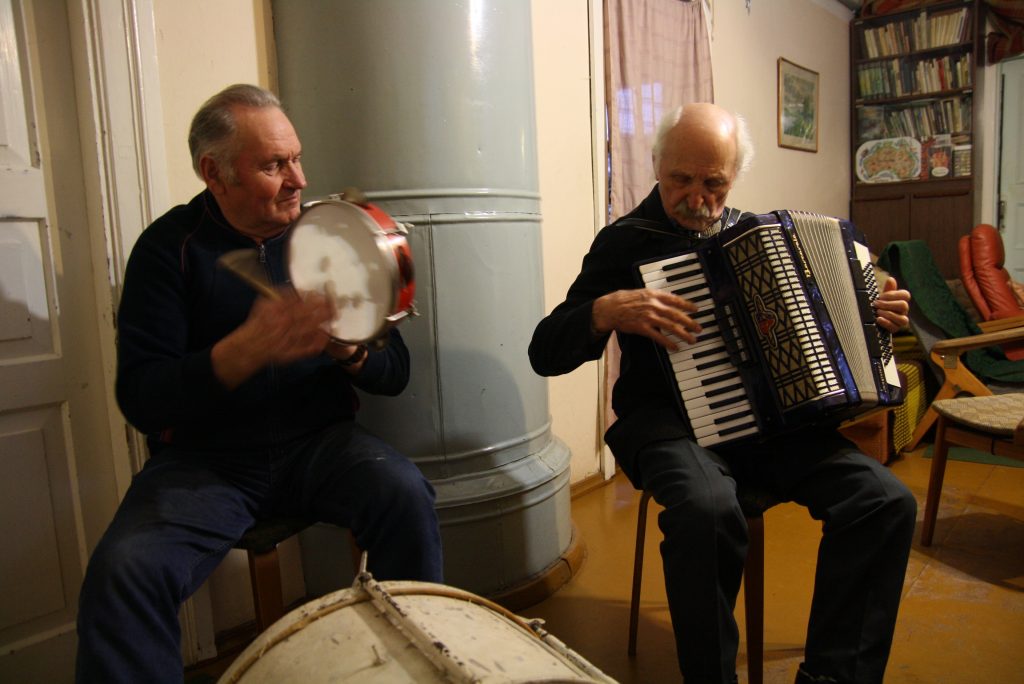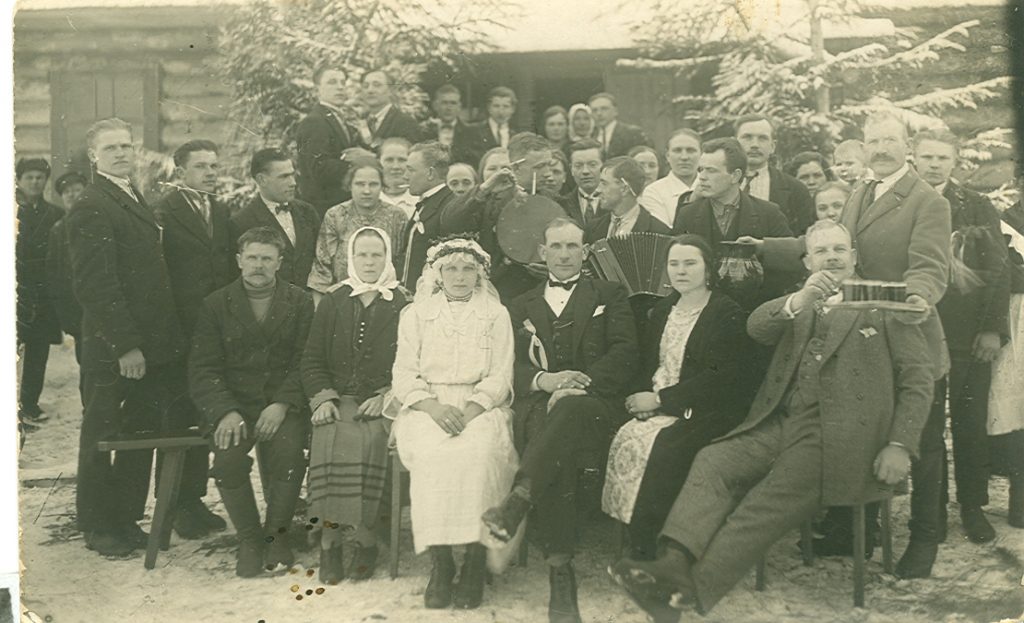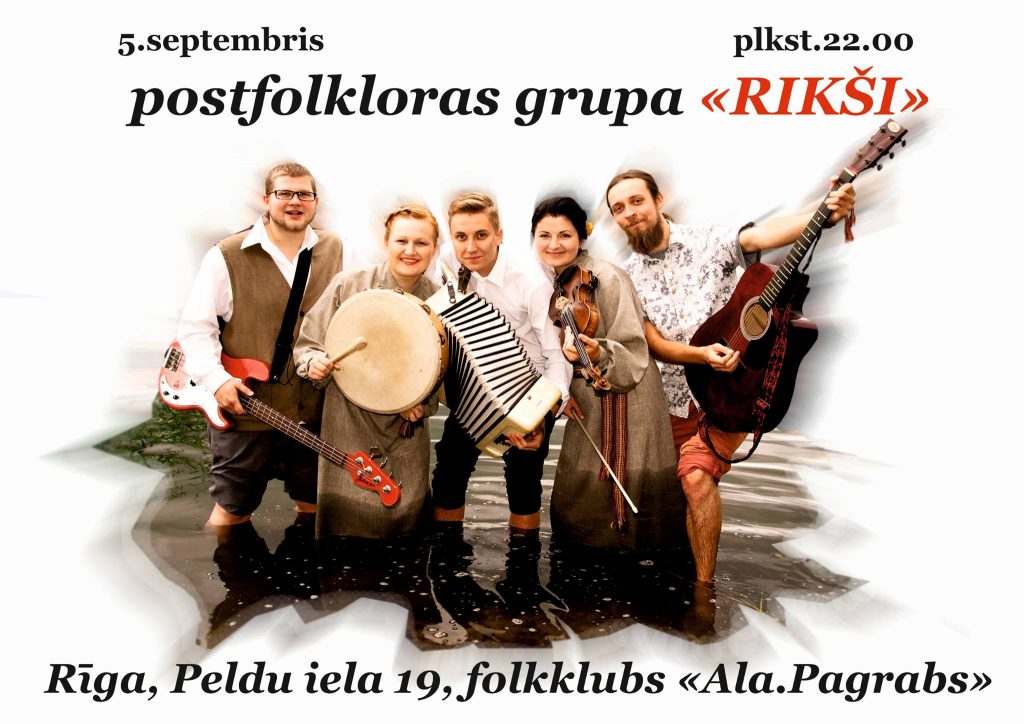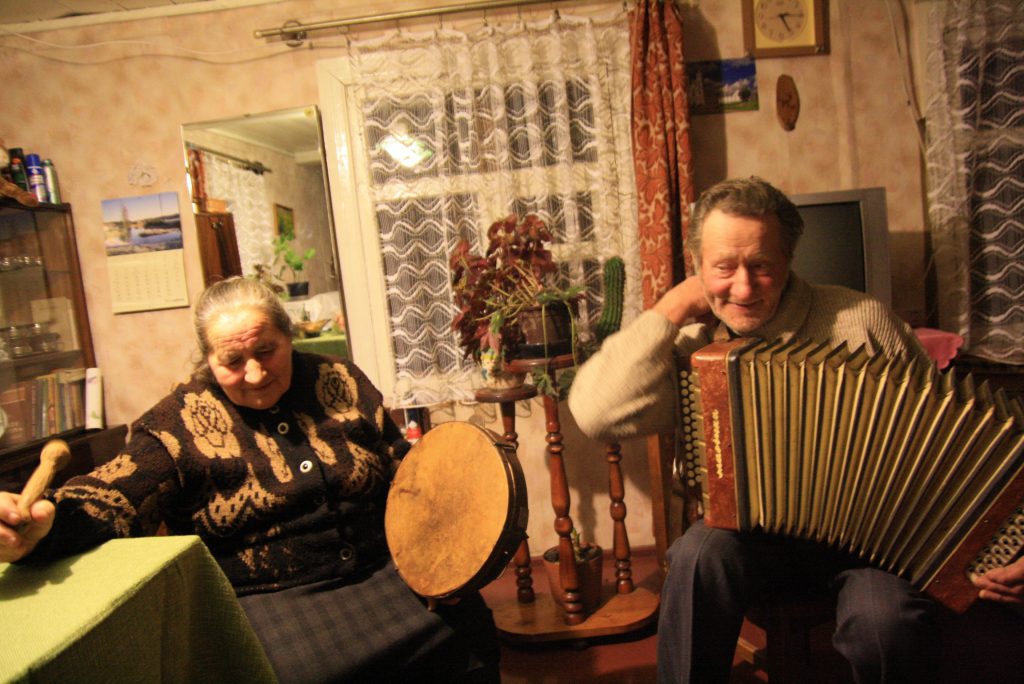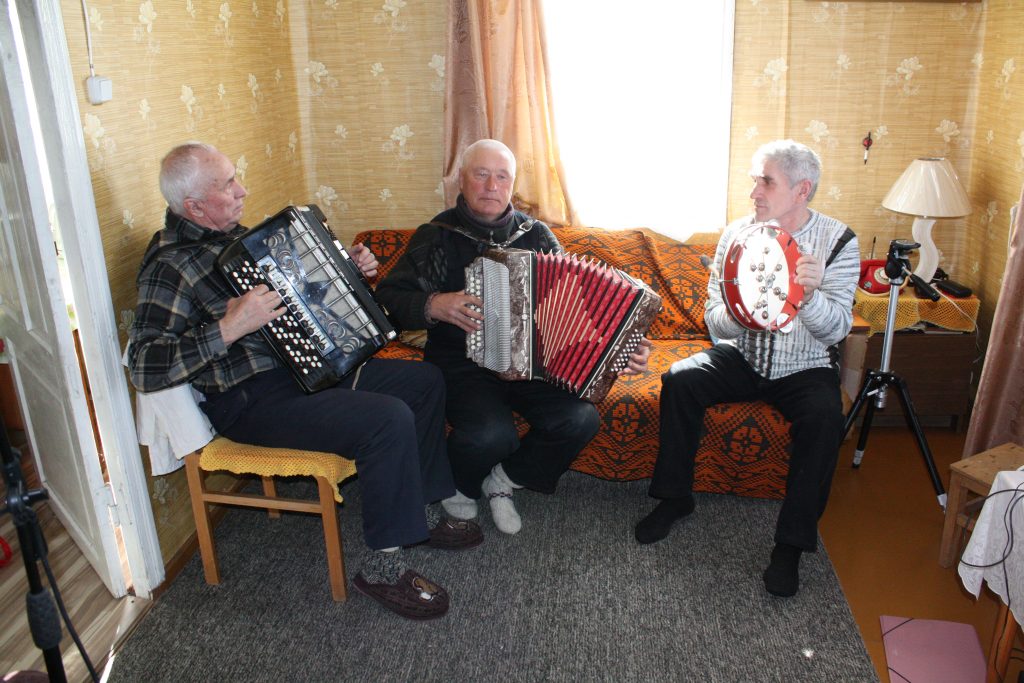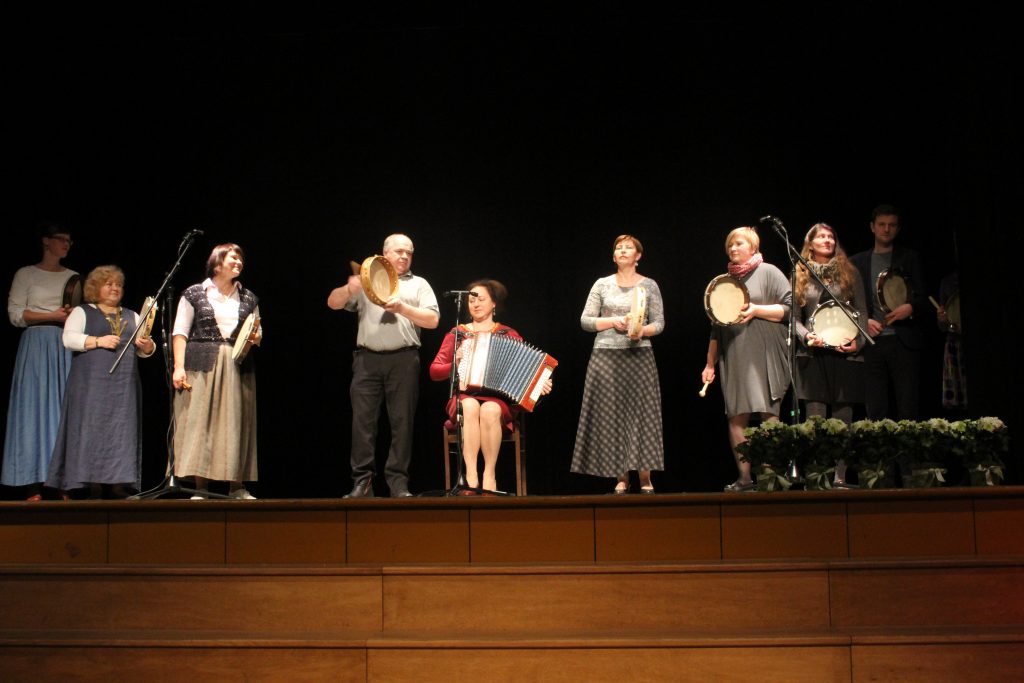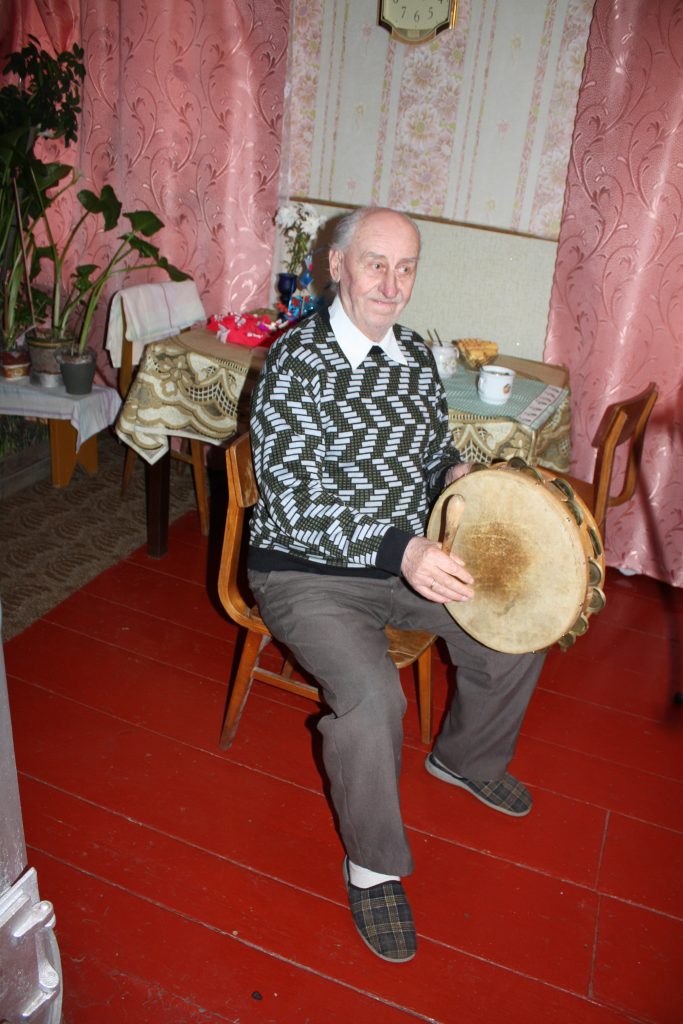Author:
Ilmārs Pumpurs
Music/performing arts
Title
The Tradition of Playing the Latgale Bubyns Frame Drum (2017)
Bubyns (Latgalian), bubna (Latg.), bubans (Latg.), rūkas bubyns (Latg.), drums, small drums – traditional instrument; kūceņš (Latg.), kalatuška (Slavic) – a cob used for the play; dasišona, pīpaleidzēšona (Latg.) – bubyna play with other instruments.
Geography
Daugavpils, Krāslava, Dagda, Preiļi, Ludza, Balvi area. The use of the element is historically fixed in the Daugavpils, Krāslava, Dagda, Preiļi, Rēzekne, Ludza, and Balvi areas. At the moment, the direct bearers of the tradition – connoisseurs of the game – are individual persons in Līvāni, Dagda, and Rēzekne. Inheritors of the tradition – players from the younger generation who have learned the skill from old masters or in folk music/folklore groups from various parts of Latvia.
The playing of the bubyna as part of a traditional music ensemble has been relatively recently identified as a separate tradition. Therefore, the wider local community does not yet perceive or recognize it as a distinct part of their cultural identity.
The element is important for individuals and groups related to the musical traditions of the region – both players and those who do not play or play any other instrument themselves but can accurately describe the place of the bubyna in the instrumental composition, the sound quality, and the skill of the player.
Players of the bubyna and other instruments are happy to share information about the typical music-making traditions, incl. the described element; however, due to the changes in the cultural environment, direct inheritance of this tradition in domestic music among local communities no longer occurs.
The learning and popularization of the tradition has been taken over by members of folklore ensembles, ethnomusic specialists and interested parties, who, taking over the described tradition of playing the instrument, form a new community of users of the skill.
Significance in community life
The playing of Latgalian frame drums, or bubyna, is part of a traditional music ensemble and equally participates in music making – at social events, weddings, house parties, nowadays also at concerts, festivals, etc.
Similar to other rhythm instruments, the main function of the bubyna in the ensemble is “dasišona, pīpaleidzēšona”. However, the technique characteristic of the play, namely, varying the rhythms according to the meaning, brings it closer to the solo instruments of the ensemble.
The bubyna can be played together with violins, a cimbole, mandolin, guitar, and hermonicas (in the second half of the 20th century – accordion) in various combinations.
A composition of musicians with a bubyna and one garmon (historically Petersburg type, nowadays also hromka or bajans) was quite common, which is already enough for making music.
Activities
The bubyna play is characterized by a special technique, with a small (about a span length) mallet – kalatuška – varying hits with the fingers or palm, simple (with hand movements from above) and combined blows (with varying hand movements from above and below) with the mallet and shaking the jingles that are attached to the side of the instrument, as well as tapping the rim or making a squeaking sound with the thumb against the pitched edge of the bubyna leather.
In the diverse use of techniques, the individual manner and mastery of the player is vividly put on display, perhaps in the past the instrument was used to demonstrate dexterity, in competition between players, not only to provide music.
Beliefs, rituals, and unwritten rules
Specific beliefs are related to the making of the instrument.
It is considered that a dog's skin is the best for the instrument. Before that, you should make the dog howl; then it sounds better.
The opportunity to sacrifice an old dog to create the instrument is considered a matter of honor. Tradition also determines the character of the sound of the instrument; the skin of the instrument should sound low, hollow, and the sound of jingles should not be too shrill.
Brass is considered to be the best material for jingles.
Passing on and transferring skills
All the surveyed instrument players have initially learned the complicated play technique by watching another musician play, without special training or exercises.
Nowadays, when an opportunity to observe a skilled musician is very limited, the best way of inheritance is methodical teaching of the craft, focusing on both the play's technique and the rhythm's variation.
History
The frame drum play in the described technique is owned by a wider cultural region and is similarly known in Lithuania (mostly in Aukštaitija) and Belarus, but the applicants do not have any scientific research on the historical origin and prevalence of the play technique (unlike the instrument itself – the frame drums that have been distributed in north-east Europe since the 11th century).
The currently identified materials show that it has been used in Latgale since at least the end of the 19th century and was a common, widespread music-making practice.
The intensive functioning of the tradition continued until the mid-20th century when the oldest acoustic musical traditions began rapidly decreasing in numbers.
By the beginning of the 20th century, individual players had preserved these skills, some of which were shown during public events.
In the traditional instrument chapel, the bubyna provides the function of a rhythm instrument, but the expression characteristic to the playstyle, as well as the variation of rhythmic shapes, allows it to be compared to a solo instrument play.
The specifics of the bubyna play allow its players to freely join other instrument players (in documented traditions with one or two violins, a cimbole, mandolin, guitar, and hermonicas in different combinations), demonstrating their skill.
The evidence obtained from the Lithuanian border area (Zarasa area) makes it possible to believe that in the first half of the 20th-century young boys used the instrument in competitions, their performances, the attestation of the skills.
The bubyna, like other instruments, determines a certain prestige in society. The possibility of giving an old dog to the owner of the instrument was also regarded as a matter of honour.
Today, the instrument play continues to be an attestation of the player's individual mastery, it gains added value as part of the cultural heritage of the Latgale region.
The instrument is suitable for demonstrating the idea of the special adventurousness and expression traditional in Latgalian music.
The most successful example of the traditional instrument play in modern culture is the Rēzekne postfolk group “Rikši”, the bubyna player Zane Dukalska, who has significantly contributed to the recognition and interest of the instrument.
At the base level, the instrument's play is relatively easy to learn, inexpensive, and easily accessible (industrially produced analogs are available, and at least two masters in Latvia have started making instruments).
This has generally raised the interest of players in learning to play the instrument.
Over the past few years, more than 20 interested parties have tried to learn the Latgale bubyna playing technique.
Unfortunately, in regions where this tradition has historically been represented, there is no further interest among musicians.
Additional Information
A bubyna player needs the same knowledge as a player of any other instrument – familiarity with traditional and dance music's repertoire and styles and the ability to cooperate while playing in an ensemble.
Masters
Pēteris Verebs – the best player of the older generation from Dagda, who learned the instrument play directly, actively participates in folk music events.
Players of the new generation who have learned to play the instrument in courses and master classes and play it at a recognized level in various music groups:
• Zane Dukaļska (music group “Rikši”);
• Edīte Husare and Ieva Artmane (folklore group “Dandari”);
• Dzintra Ločmele (“Ķekavas muzikanti”).
Agencies and institutions
The organisation “Skaņumāja” has prepared and updated the application for this element of Intangible Cultural Heritage, provided educational and popularization events, and instrument production.
Jānis Ivanovs from Rēzekne Music Secondary School provides training for traditional music specialists, incl. knowledge of Latgale music traditions, learning to play the instrument.
Consolidation
Mutually complementary element conservation activities take several directions.
PROMOTION OF THE TRADITION, INCLUDING THROUGH PRACTICAL USE IN CONCERTS
• The instrument can be viewed and is demonstrated in the “Skaņumāja” exhibition of traditional instruments;
• 2019. The theme of the international folk music festival “Dzīvā mūzika” was the playing of small drums in Latvia and neighboring countries; several concerts, and informative lectures/demonstrations;
• 2020. In the video concert cycle “Pērles kabatā”, a film “Bubyns” was created with the programs of several traditional music groups https://www.muzikanti.lv/bubyns;
• A number of traditional music and folklore groups are demonstrating bubyna play in performances – “Rikši” (until 2018), “Dzilna”, “Sēļu muižas muzikanti”, “Dandari”, “Skaņumājas muzikanti”, “Brička”, “Josta”, “Ore”, “Svātra”, “Vīteri”;
• 2021 Zane Dukaļska prepared material and created a website https://www.skaniarmani.lv/, which introduces the play of the instrument, its players, and manufacturers.
RESEARCH AND DOCUMENTATION
Zane Dukaļska has developed an ethnomusicological Master's Thesis “Rāmja bungu bubyna tradīcija Latgalē” (The Frame Drum Bubyna Tradition in Latgale). The “Skaņumāja” video concert cycle “Pērles kabatā. Bubyns” (Pearls in the pocket. Bubyns) documented several players (Sandra Lipska, Indra Jaundāldere, Andris Rutkovskis), who acquired skills through education.
TRAINING TO PLAY
The training takes place in the form of annual master classes, master classes in the project “Saspēlēsim Skaņumājā” by various organizers (Rēzekne, Iecava, Daugavpils, Mazsalaca municipality), creative camps by folklore dance ensembles in Dandari, etc. The master classes are led by Z. Dukaļska, S. Lipska, I. Artmane, A. Maļkevics. JIRMV offers to learn playing skills both for students of the Traditional Music Program and in extracurricular projects. The video tutorials created by Z. Dukaļska are published on the page skaniarmani.lv.
PROVISION/MANUFACTURE OF MUSICAL INSTRUMENTS
Several masters offer the production of new instruments – Gunārs Igaunis (“Baltharmonia”), Artis Rubuļnīks, Ilmārs Pumpurs (“Skaņumājas tautas mūzikas instrumentu darbnīca”). The “Skaņumāja” workshop offers a traditional model of an instrument with a stretchable membrane.
There has been increased recognition of the value of intangible culture, the understanding of society, and interest in the specifics and application of playing the instrument. An increasing number of people are interested in master classes and there is a demand for instruments. The number of musical collectives has increased in annual folklore groups that use the bubyna in accordance with tradition. Several players have developed their skills to an expert level, which increases both learning opportunities and practical use in music groups and projects.
The activities so far have been carried out mainly thanks to the support of VKKF (music events, play courses, documentation, other popularisation events), the funding of the National Culture Center (educational and musical events), the support of local governments (purchase of instruments, support for organisation of music events), the investment of private interested parties (purchase of instruments, tuition costs).
Continuation/development
All created resources for the promotion of this value will be maintained – web pages with informative, educational and artistic materials, the exposition of “Skaņumāja” instruments.
Visitors of the Baltica 2022 festival will have the opportunity to familiarize themselves with the traditions of the bubyna play. Opportunities will be used to attract relevant music groups and performers, to inform the public and participants in other musical and traditional cultural events.
Regular provision of educational opportunities, training in courses, and master classes, will continue. The production of high-quality instruments in the “Skaņumāja” workshop will be continued, improving production technologies for ease of use and cost reduction.
Include the element as one of the skills to be acquired as part of the planned traditional instrument-playing program in professional culture education institutions.
The “Skaņumāja” organisation will monitor the dynamics of the use of the instrument, the identification and documentation of modern players, and the identification and collection of historical evidence, photographs, instruments etc.
The goals of these events are intangible cultural values – preserving, protecting, and popularizing the tradition of playing the small drums. To ensure the availability of sufficient quality information of all kinds, the representation of the tradition in musical and cultural events, the provision of inheritance through education, and maintaining the number of experts necessary for stable maintenance and distribution.
Threats
There are several different levels of threats in the preservation of the element:
• All musical traditions, including bubyna play, can no longer remain in their historical forms because of cultural changes and no mechanism has been established so far for its targeted and sufficient preservation;
• The insufficient amount of quality available information (printed literature, internet resources, audio and video materials) reduces the competition possibilities of the traditional instrument against the elements of popular culture, even when creating folk or traditional music interpretations;
• Currently, playing the bubyna is becoming a fashion trend in the circles of people related to folklore. The pursuit of a faster result without sufficient knowledge of the techniques and historical context can lead to the leveling of the tradition and its incomplete preservation.
Applicant
Organisation “Skaņumāja” , Reg. No. 40008106801
Image Gallery
Video
Publications
Muktupavels V. (2017). Tautas mūzikas instrumenti Latvijā (Folk Music Instruments in Latvia). Riga: Academic Publication of the University of Latvia.
Locmele I. (2012). Bubyns. Latgolys lingvoterritoraluo vourdneica. Rezekne: Rezekne Academy.

